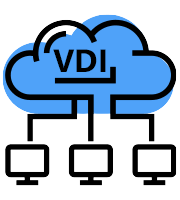Virtual Desktop Infrastructure, or VDI, is a technology that delivers remote access to the users. It has made it possible for many small, medium, and big businesses to operate effectively from remote locations. Most firms have adopted these virtualization technologies to have a cost-effective remote workforce, from on-premise VDI to cloud VDI solutions.
Citrix and VMware, two of the most prominent VDI vendors, have played a critical role in supplying this massive industry. Because of the increasing level of competition and innovation in VDI technology, understanding each provider’s VDI configuration is getting more difficult.
Let’s compare Citrix and VMware, two virtualization systems, and decide which suits you the best.
Based on Product Classification, Citrix vs. VMware VDI
What is Citrix VDI?
- Citrix is a global corporation located in Florida that sells virtualization software under the following brand names:
- Virtual Apps from Citrix (formerly known as Citrix XenApp),
- Citrix Virtual Apps and Desktops (formerly known as Citrix XenDesktop)
- Citrix’s Hypervisor (previously called Citrix XenServer)
What is VMware VDI?
VMware is a global corporation located in California that sells virtualization software under the following brand names:
- VMware ESXi is a category one hypervisor for enterprises.
- VMware vSAN is a storage virtualization product for enterprises.
- VMware NSX is a network virtualization and security platform developed by VMware.
- VMware Horizon is a virtual desktop infrastructure (VDI) solution that is similar to Citrix Virtual Apps and Desktops.
VMware Horizon vs. Citrix XenDesktop
Citrix and VMware both have a virtual desktop architecture that typically includes Hypervisor, Connection Broker, provisioning tools, Front End Systems, and an External Gateway.
Let’s look at how these components compare between the two solutions(Citrix vs. VMware vdi)
- Hypervisor
Virtual Apps and Desktops from Citrix: Citrix Hypervisor, VMware ESXi, and Microsoft Hyper-V are all supported by Citrix for on-premise VDI deployments. It’s compatible with Amazon Web Services (AWS) and Microsoft Azure. MSPs are also delivering Citrix managed services on their cloud infrastructure in the cloud.
VMware Horizon: VMware currently only offers a single hypervisor, VMware ESXi, for on-premise deployments. On the other hand, VMware provides some versatility in the cloud sector by running on Microsoft Azure, Amazon AWS, and IBM Cloud.
- Connection Broker
Virtual Apps and Desktops from Citrix: It provides brokering services through its Delivery Controller, which is in charge of resource distribution. The Delivery Controller is a server component that handles virtual desktop or app access and interfaces with the database.
VMware Horizon: Its View Connection Servers provide brokering services, allowing users to communicate with resources (similar to Citrix). It verifies users’ identities and directs them to the correct virtual machine. It also has administration features, including sign-on features and the ability to set up various rules.
- Technology Provisioning
Virtual Apps and Desktops from Citrix: PVS or Provisioning Services is a software solution that uses shared disc images to transmit configuration or update information to endpoint devices. As a result, enterprises may reduce the number of disc images they need to manage. PVS also provides excellent scalability by allowing virtual machines to start from a separate Citrix Provisioning Server that handles all requests in a shared way.
MCS, or Machine Creation Services, is another provisioning technology used by Citrix. It’s also a software feature that enables users to duplicate virtual machine configurations using a single base image. PVS provides outstanding scalability and disc space savings. However, MCS can provide you with enough network resiliency.
VMware Horizon: Linked clones and Instant clones are two provisioning solutions offered by VMware. Citrix’s MCS is comparable to linked clones. In connected clones, parent virtual machines are used to make copies, and clones rely on a software component called View Composer. View Composer controls the resources’ availability. With the vmFork technology, an Instant Clone is produced from the memory of an already functioning parent virtual machine.
The Final Decision
Choosing between Citrix vs. VMware VDI options always prioritizes what’s essential to your company. Citrix was the first company to market in the application virtualization field, and it is widely regarded as the most reliable application virtualization solution. Years of development have resulted in Citrix having a profusion of configuration choices that will almost probably fulfill any demand you may have. Those years of expertise helped them move effectively to desktop virtualization since Citrix Virtual Desktops are a solid solution that can satisfy any request you throw at it.


